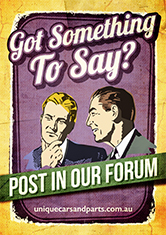|
|
With the exception of the last six months, 1941-45 was a period of almost total war production. Most of the truck manufacturers turned out military trucks of various types, whereas the car manufacturers were usually engaged in the production of totally different equipment. The main exceptions were Rootes (Hillman, Humber) and Standard. These companies produced large quantities of military cars and derivatives such as light trucks and light armoured cars, although they (and the truck industry) also turned out a variety of other items. Most civilian car owners laid their vehicles up 'for the duration'. May 1945 saw the end of the war on the continent of Europe, and in the following August the Japanese surrendered. Production of vehicles, aircraft, etc., for the Services soon tailed off and the motor industry began gradually to revert to civilian work. Many 1939/40 models were reintroduced, usually incorporating detail modifications. |
 |
 |
 |
Austin Ten Model G RQ |
| |
Also see: Austin Road Tests and Reviews |
| |
Austin Ten, Model G RQ, as used by the Forces, was a civilian saloon with a few modifications. The engine was a 9·99 HP 1125-cc side-valve Four of 29·5 bhp. The car was identical to the 1940 model, the only exception being that the gearbox third motion shaft flange was separate instead of integral with the shaft. From 1945 to 1947 it was continued as Model GS1 . The car shown served with the RAF in the Far East.
|
|
 |
 |
 |
Austin Ten Light Utility Model G/YG |
| |
Also see: Austin Road Tests and Reviews |
| |
The Austin Ten Light Utility, Model G/YG, was a modification of the Ten Saloon. It had two seats in the cab and two folding seats in the canvas-top rear body. Other notable differences when compared with the car were larger bore (66·65 v. 63·5 mm. resulting in 1237-cc capacity), addition of a water pump, lower gear ratios (final drive 6·14 v. 5·38 to 1). 8½ v. 6-gallon fuel tank and cross-country type tyres.
|
|
 |
 |
 |
Auxiliary Territorial Service |
| |
|
| |
Typical line-up of vehicles operated by the ATS (Auxiliary Territorial Service), awaiting an inspection by the Princess Royal on 20 September 1941. The vehicles are, from left to right: Ariel W/NG motorcycle, Austin 8 HP Two-Seater, Humber Super Snipe and Ford WOA 1 staff saloons, Ford 30 HP Utility, Austin 10 HP Light Utility and Morris-Commercial CS11/30F Heavy Ambulance. Some of the vehicles shown in this wartime section were already in production in 1939/40. |
|
 |
 |
 |
Daimler Scout and Armoured Cars |
| |
Also see: Daimler Road Tests and Reviews |
| |
Daimler automotive production during the war consisted mainly of Scout Cars and Armoured Cars. Total production figures were 6626 and 2694 respectively. The Scout Car, popularly known as the Daimler 'Dingo' (after a fast and rugged Aussie dog), weighed about three tons. The 55-bhp 2·52-litre OHV engine, located at the rear.
|
|
 |
 |
 |
Ford E83W 10-cwt Van |
| |
Also see: Ford UK Road Tests and Reviews |
| |
The Ford E83W 10-cwt Van, converted into Utilicon seven-seater by Martin Waiter Ltd. It had the 10 HP 1172-cc engine of the Prefect Saloon and a wheelbase of 7 ft 10 in. The Royal Navy and the Royal Air Force were among the users of the van and the conversion.
|
|
 |
 |
 |
Ford WOA1 Staff Car |
| |
Also see: Ford UK Road Tests and Reviews |
| |
Ford WOA1 Staff Car used the body of the pre-war Model 62 Saloon, but with a military pattern front end and 30 HP 85-bhp V8 engine. Tyre size was 9.00-13 or 6.50-16 (Model WOA1/A). During 1939-45 Ford Dagenham built about 360,000 fighting and transport vehicles to a total value of £138 million, and paid £25 million in wages and £12¾ million in taxes.
|
|
 |
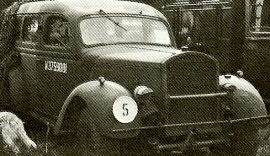 |
 |
Ford WOA2 Heavy Utility |
| |
Also see: Ford UK Road Tests and Reviews |
| |
The Ford WOA2 Heavy Utility variant of the WOA1 was in production during 1941-44 and many remained in civilian use after the war.
|
|
 |
 |
 |
Ford WOA2 Tourer |
| |
Also see: Ford UK Road Tests and Reviews |
| |
The Ford WOA2 Tourer was a soft-top conversion of the Heavy Utility car. Such modifications, used mainly in North Africa, were also carried out on Humbers and Canadian Fords.
|
|
 |
 |
 |
Hillman Minx Light Utility |
| |
Also see: Hillman Road Tests and Reviews |
| |
Hillman produced large numbers of Minx-based Light Utility 2 + 2-seaters, shown here with the canvas top removed. The two rear seats were of the folding type. There were several modifications for the many production contracts. This is an early model Mk1.
|
|
 |
 |
 |
Hillman 10 HP Light Utility |
| |
Also see: Hillman Road Tests and Reviews |
| |
Hillman 10 HP Light Utility interior. Note the additional emergency seats at the extreme rear. This vehicle was one of many supplied to the Royal Air Force.
|
|
 |
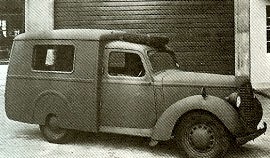 |
 |
Hillman Convertible Van |
| |
Also see: Hillman Road Tests and Reviews |
| |
The Hillman Convertible Van, used by the RAF, was another vehicle based on the Minx car. Basically it was similar to the Light Utility, but it had a van-type body with side windows and could be used for the transport of either personnel or goods. Another variant was the alllenclosed Ladder Van, fitted out for airfield lighting maintenance.
|
|
 |
 |
 |
Hillman 10 HP chassis with Turreted Armoured Hull (aka the "Gnat") |
| |
Also see: Hillman Road Tests and Reviews |
| |
Hillman 10 HP chassis with turreted armoured hull. This neat little armoured car, named Gnat, did not get beyond the experimental stage. The engine was mounted at the rear, the driver sitting in the forward end. Note the single headlamp, fitted with black-out mask.
|
|
 |
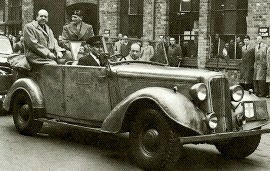 |
 |
Humber Super Snipe Tourer |
| |
Also see: Humber Road Tests and Reviews |
| |
The Humber Super Snipe Tourer was used extensively by Field Marshal Viscount Montgomery of Alamein. This picture was taken in 1952 when he paid a visit to the Coventry works of Rootes Motors Ltd, the parent company of Humber Ltd. Accompanied by Lord Rootes and Mr Geoffrey Rootes, he is touring the Stoke factory in one of his wartime cars, dubbed 'Old Faithful'. This car (M239459) served the Field Marshal in North Africa and Italy.
|
|
 |
 |
 |
Humber Super Snipe Staff Saloon |
| |
Also see: Humber Road Tests and Reviews |
| |
This is a 1941 model which had larger tyres (9.00-13) and wider wings than the 1940 model. It is shown in an Arab village during the Western Desert war in 1942. The windscreen was partly painted in order to minimize light reflection and detection from the air.
|
|
 |
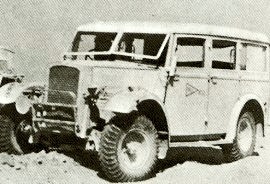 |
 |
Humber Super Snipe Heavy Utility |
| |
Also see: Humber Road Tests and Reviews |
| |
The Humber Super Snipe Heavy Utility was another variant on this widely used chassis. It was a military type estate car, used mainly by the Army and the RAF. This specimen was converted for wireless use and featured a canvas instead of metal roof. In one or two instances the complete top was removed, turning the car into a Tourer with folding canvas top. There was also an 8-cwt truck version with soft-top cab. Some of the latter were later fitted with staff saloon bodywork.
|
|
 |
 |
 |
Humber "Soft Skin" Military Vehicles |
| |
Also see: Humber Road Tests and Reviews |
| |
Humber produced a large variety of 'soft-skin' and armoured military vehicles, using the same basic engine and other components throughout the range. Pictured left is a Pullman Limousine, a Special lronside Saloon and a rear-engined 4 x 4 Armoured Car, Mark I, all part of the fleet of vehicles used by HM King George VI. The Pullman was one of three with special bullet-proof (austenitic steel) coachwork. In the background is Windsor Castle.
|
|
 |
 |
 |
Humber Light Armoured Car on Super Snipe chassis |
| |
Also see: Humber Road Tests and Reviews |
| |
Humber light armoured car, built on the Super Snipe chassis. Early models, produced for Home Defence following the Dunkirk evacuation, were known as Humberette. Illustrated is their follow-up, first produced in July 1940 and officially designated 'Car, 4 x 2, Light Reconnaissance, Humber Mk I, Ironside I. It featured WD pattern divided-rim wheels with 9'25-16 Runflat tyres, and was superseded by the turreted Mk II and the four-wheel drive Mk III and IliA. Altogether some 3600 were built.
|
|
 |
 |
 |
Humber Special lronside Saloon |
| |
Also see: Humber Road Tests and Reviews |
| |
Humber Special lronside Saloons were used by the Royal Family and Cabinet Ministers. They were derived from the standard lronside and had a division between front and rear compartment. The left-hand front seat back squab could be folded forward and the Perspex division panel moved to the right to facilitate access to the rear seat. Equipment in the rear compartment included an 8-day clock, a microphone to the driver, a wool rug and a fire extinguisher. Upholstery was hide, with West of England cloth on the sides, below waist level.
|
|
 |
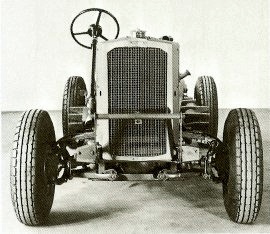 |
 |
Humber F.W.D. chassis |
| |
Also see: Humber Road Tests and Reviews |
| |
Humber F.W.D. chassis was derived from the Super Snipe but as the model designation indicates. featured four-wheel drive. The chassis was used for utility cars. armoured reconnaissance cars and 8-cwt trucks and field ambulances. In addition to the conventional four-speed gearbox. it had a two-speed auxiliary gearbox. providing eight forward and two reverse speeds. Front suspension was independent.
|
|
 |
 |
 |
Humber four-wheel drive (4 x 4) Heavy Utility |
| |
Also see: Humber Road Tests and Reviews |
| |
Humber four-wheel drive (4 x 4) Heavy Utility car under test negotiating a deep mud and water course at 30 mph. These cars weighed almost 2½ tons.
|
|
 |
 |
 |
Humber Heavy Utility and Light Reconnaissance Car |
| |
Also see: Humber Road Tests and Reviews |
| |
Humber Heavy Utility and Light Reconnaissance Car, Mk Ill, in the North African desert. Both used the same four-wheel drive chassis with 9 ft 3 in wheelbase and 9·25-16 tyres.
|
|
 |
 |
 |
Humber F.W.D. Heavy Utility |
| |
Also see: Humber Road Tests and Reviews |
| |
Humber F.W.D. Heavy Utility after 'demob'. Many remained in military service until long after the war: others found their way to 'Civvy Street'. These smartly turned out examples were used by the BBC (who, during the war, employed a conversion of the ambulance version on this chassis as recording vans for use in battle zones).
|
|
 |
 |
 |
Morris 8 HP Light Utility |
| |
Also see: Morris Car Review |
| |
Morris 8 HP Light Utility was based on the pre-war GPO van. Few were made, most Morris Light Utility cars being of the 10 HP type. |
|
 |
 |
 |
Morris 10 HP Light Utility |
| |
Also see: Morris Car Review |
| |
Morris 10 HP Light Utility vehicles on the assembly line at Cowley, Oxford. These are early production models, still featuring the civilian type radiator grille and headlamps. |
|
 |
 |
 |
Morris Light Reconnaissance Cars |
| |
Also see: Morris Car Review |
| |
Morris Light Reconnaissance Cars were built in Mk I (4 x 2) and Mk II (4 x 4) versions, both with the engine at the rear. The former had IFS. The engine was a Morris EK four-cylinder petrol unit of 3·52-litre cubic capacity, producing 71 bhp, driving through a four-speed main gearbox and a two-speed transfer case. 2200 were produced, for the Army and the RAF. |
|
 |
 |
 |
Park Ward Ambulance |
| |
|
| |
Heavy and powerful American cars were particularly suitable for conversion into boxvan-type canteens, ambulances, fire service control rooms, etc. A typical example of an ambulance body by Park Ward replacing the cut-off rear body of a 1936 Canadian-built Buick is shown here. Excessive rear overhang caused problems when lighter chassis were used. |
|
 |
 |
 |
Rootes Airframe Factory, Speke, Liverpool |
| |
|
| |
The motor industry was engaged in several other forms of war material production, including aircraft. The picture shows the erecting hall of the Rootes-operated Airframe Factory at Speke, near Liverpool. The aircraft are Bristol Blenheim high-speed bombers for the RAF. |
|
 |
 |
 |
Standard Light Armoured Car |
| |
Also see: Standard Road Tests and Reviews |
| |
Standard, at the beginning of the war, produced a number of improvised light armoured cars on their 14 HP car chassis with beam-type front axle. The armour consisted of 11-mm mild steel, backed by 3-inch thick oak planks at the front. The hull was open-topped (and open-backed on the Mk I) and the vehicles, named after their instigator Lord Beaverbrook, were used for the defence of aircraft factories and for training purposes. Wheelbase was 9 ft weight 2 tons. A Bren gun could be fired through vertical slots, front and rear. |
|
 |
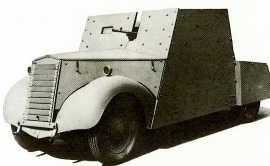 |
 |
Standard Beaverette III and IV |
| |
Also see: Standard Road Tests and Reviews |
| |
Standard Beaverette III and IV were produced when supplies of proper armour plate became available. The armour was 10 mm thick, and was bolted and welded together to form a turreted 'mobile pillbox'. |
|
 |
 |
 |
Wolseley Mobile Canteen |
| |
Also see: Wolseley Road Tests and Reviews |
| |
Wolseley mobile canteen, operated by the Salvation Army and paid for by the Christian Science War Relief Committee. This is just one example of hundreds of wartime conversions of pre-war cars. |
|
|
|
Sell Your Car or Parts
Browse the Classifieds
It's Absolutely Free! - Find Out More
|


